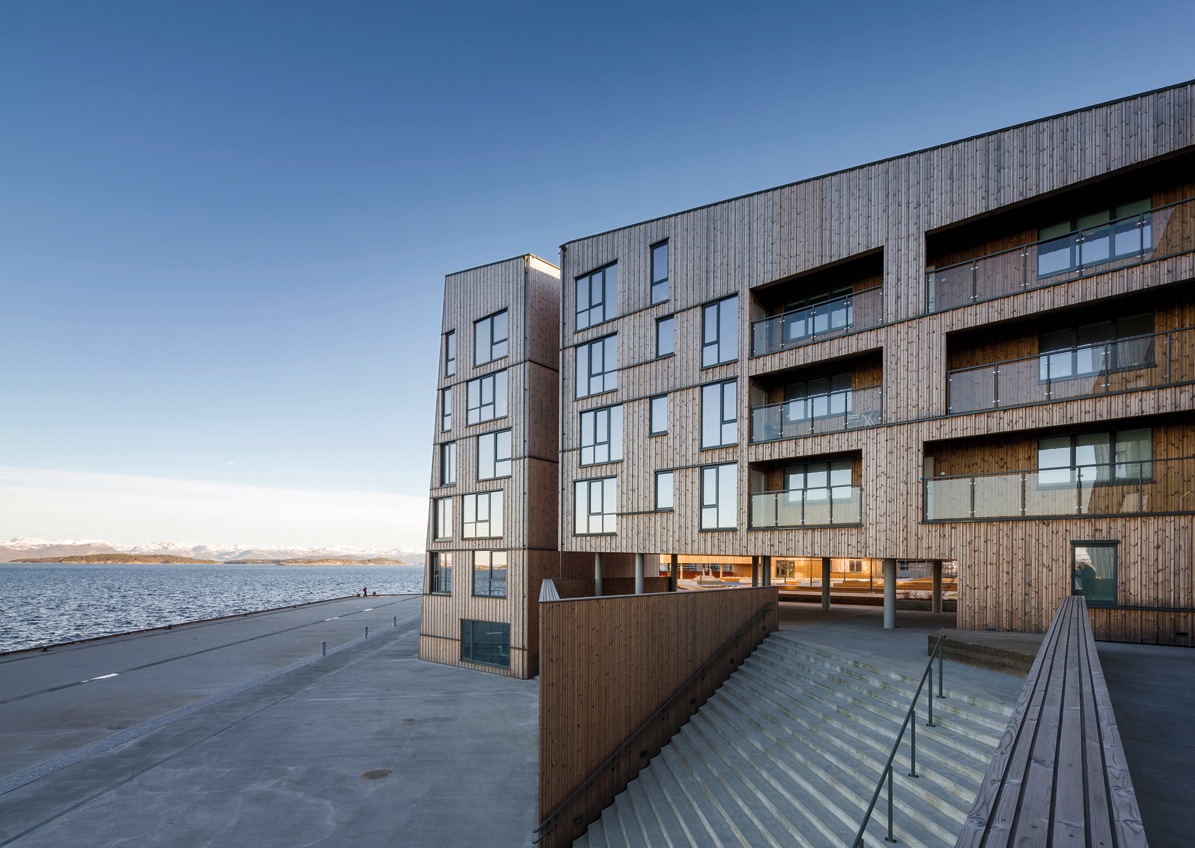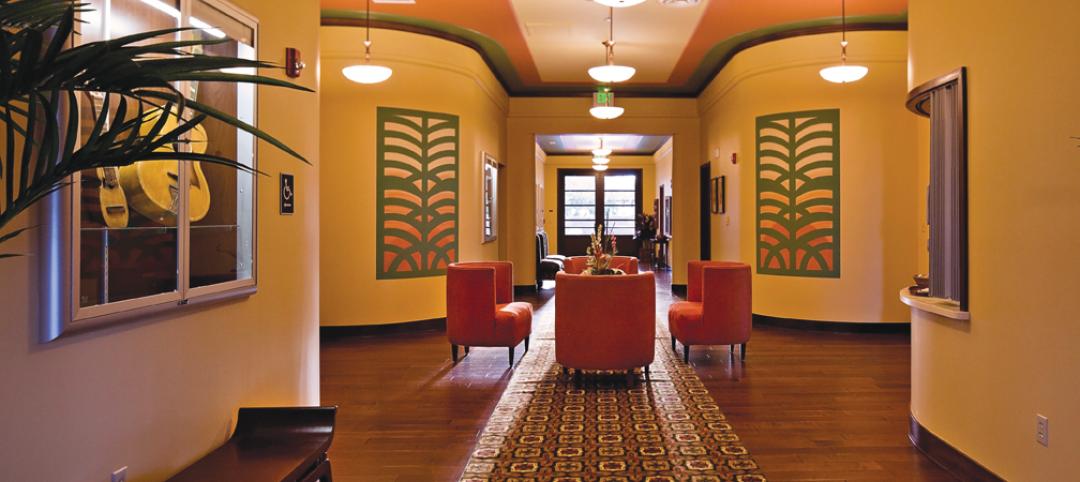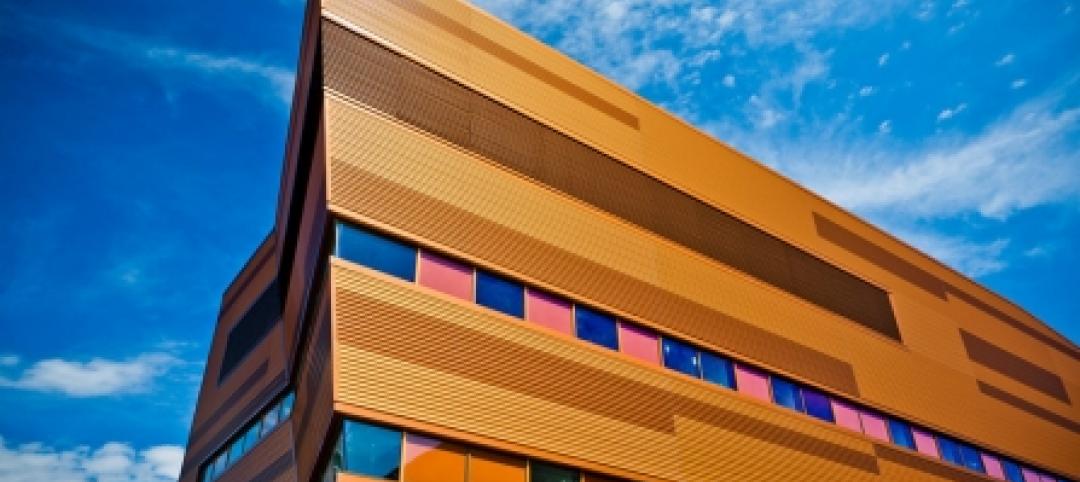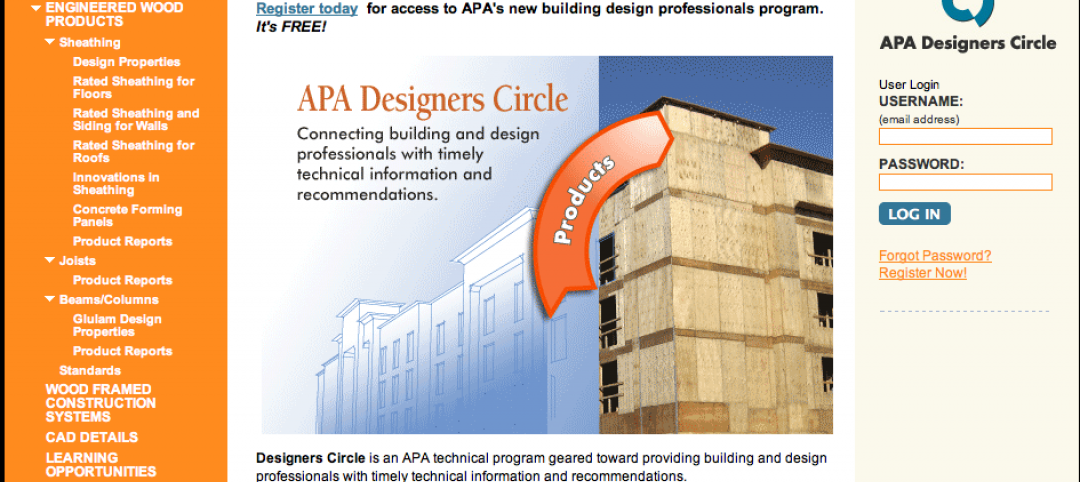The recent push for larger and taller wood structures may seem like an architectural fad—plenty of hype, but only a few dozen completed projects globally. Concrete and steel still rule the world of mid- and high-rise construction.
Still, Building Teams around the world are starting to use more large-scale structural wood systems, including heavy timbers, engineered framing systems, and other modern wood products. The number of new buildings of this kind has been trending modestly upward, spurred by such benefits as sustainability, cost effectiveness, and reduced construction impact. Leading the way: podium-type concrete and light-framed hybrids in the U.S., and heavier “mass timber” structures elsewhere.
International real estate firm Lend Lease (www.lendlease.com) used cross-laminated timber (CLT), sometimes described as “precast timber panels,” for its 10-story Forté apartment tower in Melbourne, Australia (which has been called the world’s tallest structure of its type) and in the $18 million Library on The Dock, the first public building in Australia made with CLT. In the United States, Hines Interests (www.hines.com) recently announced plans for a seven-story wood-framed office building in Minneapolis.
EDITOR’S NOTE
Further online reading required for this course. To earn 1.0 AIA CES HSW learning units, study the complete article carefully and take the exam posted at www.BDCnetwork.com/WoodTowers.
LEARNING OBJECTIVES
After reading this article, you should be able to:
+ DESCRIBE the primary approaches to large-scale structural wood construction, including hybrid light framing and engineered mass timber.
+ DISCUSS the benefits and drawbacks of structural wood systems, in particular their contribution to sustainable design and green building.
+ LIST current certifications, codes, and standards that affect the use of large-scale modern wood structures.
+ COMPARE wood systems to concrete and steel in terms of availability, suitability for building types, and performance for such factors as acoustics and fire safety.
Other examples include the nine-story Stadthaus tower in London by developer Telford Homes (www.telfordhomes.plc.uk) and affordable housing manager Metropolitan Housing Trust (www.metropolitan.org.uk), with its cellular structure of a load-bearing core and timber floor slabs. From commercial projects like The Waterfront, a 210,000-sf mixed-use project in Norway, to the University of British Columbia’s five-story Earth Sciences Building academic wing, platform framing and distributed post-and-frame structures are attracting interest.
The Treet building in Bergen, Norway, reached 14 stories with all-timber bones. There’s the eight-story LifeCycle Tower One, in Dornbirn, Austria, which used wood as its primary building material. Structures up to 30 stories in height are on the boards in Norway, Austria, and Vancouver, B.C.
Last year, the Vancouver, B.C.-based Forestry Innovation Investment and Binational Softwood Lumber Council commissioned Perkins+Will (www.perkinswill.com) to interview building owners, designers, contractors, timber fabricators, and authorities having jurisdiction for a global study of the prospects for big timber. The resulting “Survey of International Tall Wood Buildings” catalogues 10 novel projects in detail.
ASSESSING THE BENEFITS OF WOOD
Teams from around the United States have submitted projects for the $2 million purse in the U.S. Department of Agriculture’s U.S. Tall Wood Prize Competition competition. Winners will “showcase the architectural and commercial viability of advanced wood products like CLT in tall buildings,” said Doug McKalip, a White House Senior Policy Advisor for Rural Affairs. He estimates that “the near-term use of CLT and other emerging wood technologies in buildings of seven to 15 stories could have the same emissions-control effect as taking more than two million cars off the road for one year.”
Sustainability is not the only reason for greater interest in wood structures. There is also the aesthetic appeal of wood—its earthy colors and aromas, fine grains, durability, dimensional stability, and what carpenters call workability.
Wood is also considered a healthy material choice, says Rebecca Holt, a Sustainable Building Advisor with Perkins+Will. “It creates a special quality of space, contributing to a feeling of warmth and well-being and supporting exceptional building performance.”
There is a strong case for wood’s reduced environmental impact, mainly that less carbon is released during its manufacture compared to other structural materials. There’s the added bonus of carbon sequestration (absorption) during the life of every tree. “The main motivation for Building Teams going bigger and taller is the environmental aspect,” says Scott Breneman, PhD, PE, SE, a Senior Technical Director in Architectural and Engineering Solutions for WoodWorks (www.woodworks.org), an initiative of the Wood Products Council, which represents North American wood associations. “There are many different ways to measure it, but there is much less carbon released during manufacture than with other, more energy-intensive manufacturing processes such as those for steel, concrete, or masonry.”
Much of that process energy comes from renewable biomass, such as bark and other residual fiber, instead of fossil fuels. Breneman also points to life cycle studies showing lower across-the-board environmental impacts for wood from cradle to cradle compared to other materials.
Sustainability was a major factor in prompting Skidmore, Owings & Merrill (www.som.com) to publish its “Timber Tower Research Project” in 2013. The report demonstrates the feasibility of a 42-story mass timber high-rise with supplementary reinforced concrete at the connecting joints.
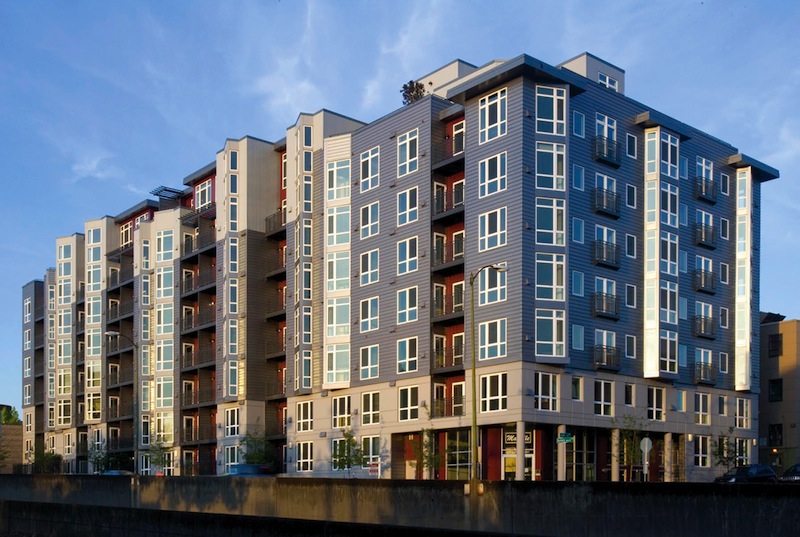 Marselle Condominiums, Seattle, designed by PB Architects, with Yu & Trochalakis as structural engineer and Norcon NW as general contractor. The 5½-story, 160,000-sf complex was built over a two-story concrete podium; it meets Type III-A construction restrictions. Extensive use of engineered wood contributed to the 132-unit development achieving Master Builders Association Built Green status. Photo: Matt Todd, courtesy U.S. Woodworks
Marselle Condominiums, Seattle, designed by PB Architects, with Yu & Trochalakis as structural engineer and Norcon NW as general contractor. The 5½-story, 160,000-sf complex was built over a two-story concrete podium; it meets Type III-A construction restrictions. Extensive use of engineered wood contributed to the 132-unit development achieving Master Builders Association Built Green status. Photo: Matt Todd, courtesy U.S. Woodworks
A top goal for SOM’s use of mass timber as the main structural material in the study was to minimize the embodied carbon footprint of the building by as much as 60–75%. The report urged additional research and physical testing to verify structural and fire-safety performance, and encouraged the design community to work creatively with municipalities and code officials “to make timber buildings a viable alternative for more sustainable tall buildings.”
Codes are already moving in the direction of allowing for larger wood structures, but not necessarily for mass-timber skyscrapers. Buildings with light wood framing of up to six stories, with up to four occupancy groups at each level, are allowable under the height and area prescriptive language of the 2012 International Building Code (http://publicecodes.cyberregs.com/icod/ibc/).
Low-rise institutional and healthcare buildings can be made of heavy timber (Type IV whole-building construction with solid or glue-laminated members, wood decking, and structural sheathing with no concealed spaces), or they can have heavy timber roofs in Type I and Type II buildings. These facilities can also meet code with Type VA or Type IIIA construction, including one-story sprinklered facilities and certain others up to five stories. WoodWorks notes that beefing up the firewall and increasing the frontage can further enlarge the allowable footprint.
The IBC and local codes have also improved the prospects for schools, senior housing, office complexes, civic centers, and recreational buildings to use wood as a structural material for projects of up to five or six stories
Increasing use of podium construction has led to imaginative and safe mid-rise structures that combine a rigid lower portion (the podium), typically a concrete slab platform, with a flexible wood-frame upper portion. In previous IBC editions, occupancy of the lower-level podium was limited to automobile parking, but few jurisdictions now restrict the first-floor uses. Typical podium structures are called five-over-one—five wood-framed floors on a concrete platform—but recently there have been more five-over-two projects, such as in Seattle, where the building code allows for a two-story podium and a combined building height up to 85 feet.
The 160,000-sf Marselle multifamily complex in Seattle, designed by PB Architects (pbarch.com) and structural engineer Yu & Trochalakis (www.ytengineers.com), used a two-story base to support five stories of light framing topped with a mezzanine level—in other words, 5.5 over two.
There are cost and schedule advantages for using wood in podium construction. If the Marselle condominium project had been built using all concrete, “it would have cost about 30% more,” says Kory Knudson, Vice President of Norcon NW, the general contractor. “If we had built the entire project out of steel, it would have taken much longer and we would have had to make many energy modifications.”
“These are lighter-weight materials, and the raw materials can be economically designed, since the hybrid structure uses the materials that are most readily available in the local markets,” says WoodWorks’s Breneman. He notes that, in the construction phase, building with wood tends to be quieter and faster than that for other materials, with fewer dirty, noisy processes like welding or grinding. “So there is a benefit to the community surrounding the construction site,” he says.
CLT and other panelized material methods and techniques can also speed on-site construction, thus helping to bring down labor allowances. “The concrete-and-steel hotel right behind Marselle had a similarly sized footprint, but our framing went up much faster,” says Joe Hanley, President of Norcon NW. “They had a lot of on-site welding, but by using wood, we were able to work through all types of weather.”
USING MASS TIMBER AND CROSS-LAMINATED TIMBER
Light wood framing has a growing number of adherents nationally. But what about heavy mass timber construction, whether with solid wood or glue-laminated, fabricated members?
“The key difference versus light frame is that mass timber is not recognized by code,” says David Barber, Global Fire Engineering Leader at Arup (www.arup.com). He says that some AHJs limit heavy-timber construction to four or six stories, with greater heights allowed if the design includes concrete.
Yet many port cities and old lumber towns have heavy wood-framed towers that date back to the 1900s—for example, the eight-story Butler Brothers building, a 1908 warehouse structure in Seattle that was adapted for office and retail uses in 1974. Barber says codes have become more conservative about building with combustible elements; in some jurisdictions, the height limitations are based on out-of-date fire-fighting practices.
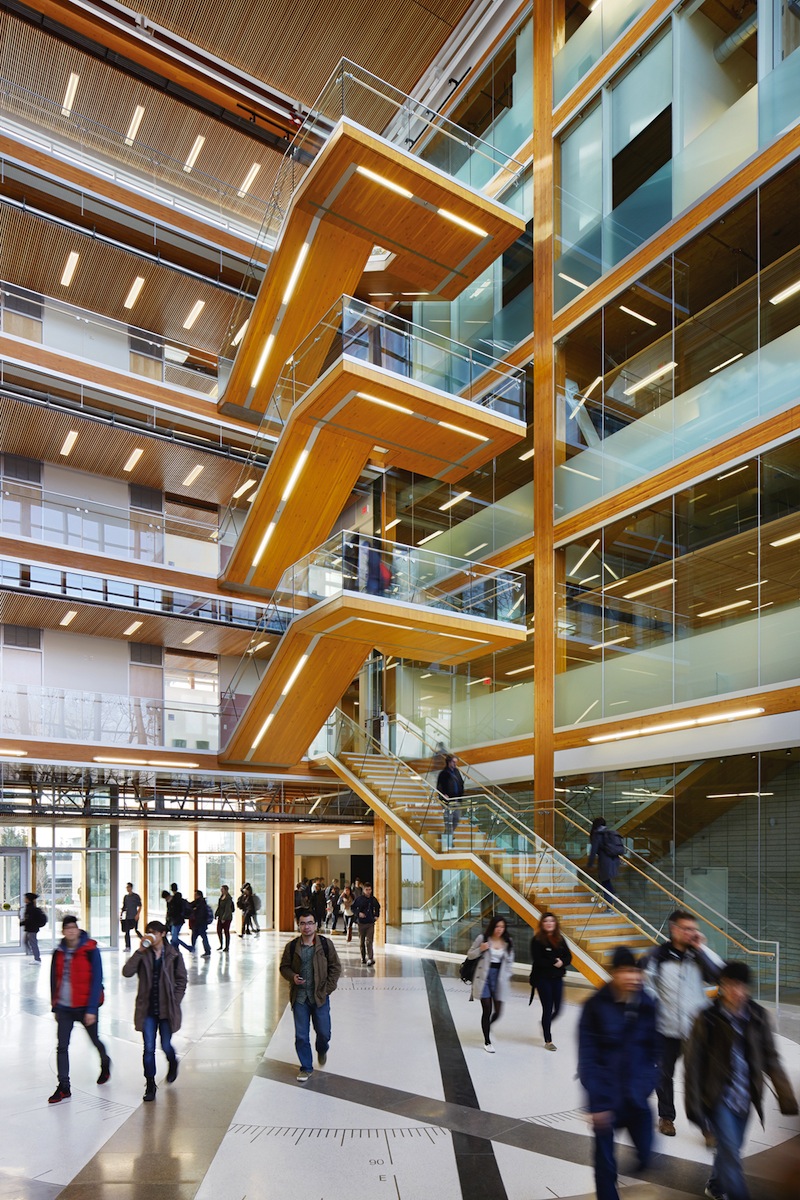 The 159,000-sf University of British Columbia’s Earth Sciences Building, called the largest use of cross-laminated timber in North America. On the Building Team: Perkins+Will (architect), Equilibrium Consulting (structural), Core Group Consultants (civil engineer), Stantec Consulting (mechanical), Acumen Engineering (electrical/technology), and Bird Construction (CM). Photo: Martin Tessler, courtesy Perkins+Will
The 159,000-sf University of British Columbia’s Earth Sciences Building, called the largest use of cross-laminated timber in North America. On the Building Team: Perkins+Will (architect), Equilibrium Consulting (structural), Core Group Consultants (civil engineer), Stantec Consulting (mechanical), Acumen Engineering (electrical/technology), and Bird Construction (CM). Photo: Martin Tessler, courtesy Perkins+Will
Proponents of big wood structures recommend modern wood products over slab timber. “We don’t like to use timber framing for taller buildings: it lacks the robustness and strength of engineered timber,” says Andrew Waugh, Founding Director of Waugh Thistleton Architects (www.waughthistleton.com), which designed the nine-story Stadthaus in London. For tall solid-timber buildings, the firm uses a combination of cross-laminated timber and glulam, either platform construction in panels, beam and post in glulam, or a hybrid of the two with solid CLT cores.
“There are many complementary engineered wood products that are well suited for tall wood buildings,” says Frederick A. Kamke, PhD, of Oregon State University’s College of Forestry. The following well-established products are available in large dimensions:
• Laminated veneer lumber (LVL)
• Parallel strand lumber (PSL), trade name “Parallel”
• Laminated strand lumber (LSL), trade name “Timberstrand”
The most popular such wood product is cross-laminated timber, or CLT. “CLT is the hot topic in the U.S. but old news in Europe, where it has been available for about 15 years,” says Kamke, Oregon State’s Jeld-Wen Professor of Wood-Based Composite Science. There are two CLT producers in Canada, but none in the U.S.
For CLT and other structural wood products, the key concerns have been fire resistance and durability. New fire-retardant coating systems for use with engineered wood composites can achieve a two-hour fire rating. CLT is being tested for long-term durability in certain U.S. climate zones, as well as for verification of seismic resistance. “These products are part of the building system; therefore, the building design must consider the entire system,” says Kamke. “If the exterior cladding fails, the long-term effects on the substructure could be devastating.”
to avoid problems, engage AN EXPERIENCED structural ENGINEER
Building Teams considering using engineered timber should engage a seasoned structural designer. “It must be a very integrated design process, with a competent structural engineer and other team members with experience,” says Michael Green, AIBC, FRAIC, AIA, Founder and Principal, Michael Green Architecture (mg-architecture.ca).
Green designed the Wood Innovation Design Centre (WIDC) in Prince George, B.C., which is on track to be the tallest in North America. He says that, without experienced team members on board, “You can get in expensive trouble pretty quickly” using wood systems. “How far apart the walls and columns are affects how big the beams will be,” he says. “Getting this wrong is very expensive with wood.” The key is to design for optimal spans between walls and beams to slim down the volume of wood. “The simpler you can be, the more cost effective it becomes,” says Green.
Green’s design for the WIDC used a post-and-beam structure of glulam with a floor deck comprising mass timber panels (such as of glulam, CLT, or structural composite lumber) instead of the load-bearing panels commonly used for CLT structures. One benefit of this approach was that it reduced the number and size of columns and allowed for more glass in the façades.
Then there’s the 159,000-sf University of British Columbia’s Earth Sciences Building, which the school calls “the largest panelized wood building and the largest application of CLT in North America.” The ESB used 1,300 tons of regionally sourced and engineered structural Douglas fir and other timber, including hybrid trusses of steel and wood, laminated strand lumber floor panels topped with concrete, and post-and-beam glulam frames.
To stiffen the building and resist lateral loads, chevron ductile bracing (also called inverted V-bracing) was employed in some areas. Inside the atrium a large cantilevered stair of solid wood climbs up five stories. Echoing the wood ceilings is a canopy of fir panels and glulam posts that wraps three sides of the first floor.
The detailing is simple, using minimal steel joinery and leaving all the wood members with a natural finish. The exterior combines cement board and large ribbon windows with natural stone and small concrete masonry units. It doesn’t look like an innovative, all-wood mid-rise; however, “as one of only three examples of modern, taller wood construction in North America, the Earth Sciences Building has become an important example of the potential of mass timber products in major construction projects,” says Perkins+Will’s Holt, a member of the design team.
Recent low- to mid-rise projects, as well as speculative tower designs, provide a glimpse into how timber framing is likely to segment in the various construction markets. Many contractors expect platform framing to dominate for construction of up to eight or 10 stories. Distributed bearing walls, post-and-frame systems, and other structural frame approaches are suitable for the taller projects in this category. They are effective for multifamily floor layouts, as the dimensions between structural walls tend to be shorter. London’s nine-story Stadthaus, with 29 living units, employs a distributed bearing-wall design with simple, off-the-shelf anchorage. Though they are bearing, a wall can be safely removed from any floor; each floor panel rests on at least two walls.
For taller timber towers, a post-and-beam structural frame is considered good practice, usually in concert with a core wall system that may be of cast-in-place concrete or other materials. This allows for fewer and more isolated columns and yields a familiar core-and-shell floor plate that commercial office developers tend to favor. SOM’s research concept for the 42-story mass timber high-rise with supplementary reinforced concrete at the connecting joints is one such example. The floor plans show long column spans and flexible, open interior spaces. Its core and curtain wall detailing would be similar to those seen in steel or concrete buildings.
The scale of projects like these raises one more test for project viability, says WoodWorks’s Breneman: available supply of the structural materials. When it comes to the U.S. mid-rise, light-frame market, supplies are excellent nationwide and plenty of contractors know the trade. Heavy-timber construction, says Breneman, is a more specialized trade, usually a small team of erectors partnering with a heavy-timber supplier.
Kris Spickler, a heavy-timber specialist with Structurlam, says, “Mid-rise and tall buildings of mass timber are in demand now, especially in Canada.” He notes that CLT works well in multifamily construction due to the product’s simplicity and strength. For office buildings and other structures that use extensive glazing or prefabricated panels, post-and-beam structures of mass timber with CLT decks can be effective.
USING WOOD TO REDUCE the project’s CARBON FOOTPRINT
Another way to enhance sustainability in wood-related projects is to use reclaimed timbers, especially for low-rise and some mid-rise buildings. Reclaimed wood is becoming so popular that its price is escalating quickly. In some projects, Building Teams have selected lumber from trees killed by mountain pine beetles, which destroy forests yet leave usable wood. A recent high-profile example is the Richmond Olympic Oval, in Vancouver, B.C., which used beetle-infested Douglas fir for the 512,000-sf skating rink’s arched roof spans.
Almost any wood is desirable, say project developers like Hines. The engineered composite wood used for its T3 project in Minneapolis appeals to many prospective tenants because it looks like old-growth lumber. Yet it is manufactured by laminating smaller timber from younger trees. CLT is produced by gluing together perpendicular bands of spruce under very high pressure. According to WoodWorks, such products recently have been available in North America in dimensions up to 19½ inches thick, 18 feet wide, and 98 feet long. “While CLT panels act as two-way slabs, the stronger direction follows the grain of the outer layers,” says WoodWorks.
This results in load-bearing walls and floors that appeal to the eye and also to end-users who are increasingly attuned to the environmental benefits of wood. For structural uses, a number of environmental advantages accrue:
General green features. Timber can be sourced from sustainably managed forests, thereby helping to protect water sources, wildlife, and culturally significant sites. Life cycle assessments tend to favor wood over steel and concrete in such measures as the amount of embodied energy and total air and water pollution created.
Carbon value. Wood products have a lighter carbon footprint than comparable structural and finish materials, in part because wood continues to store carbon that the trees absorbed while growing. Wood manufacturing tends to require less energy and results in lower greenhouse gas emissions, according to studies by the Consortium for Research on Renewable Industrial Materials (www.corrim.org) and the publication “Synthesis of Research on Wood Products & Greenhouse Gas Impacts” by the nonprofit forest research center FPInnovations (https://fpinnovations.ca).
Perkins+Will estimates that the Earth Sciences Building’s 1,300 tons of heavy timber translates to sequestration of more than 1,000 tons of carbon dioxide, roughly the same emissions from 415 cars every year. The carbon footprint of an equivalent concrete frame would be double that for the timber-framed ESB, says P+W’s Holt.
Thermal performance. The coefficient of heat transfer, or U-value, for lumber and mass timber members relates to panel thickness as well as the thermal conductivity (rate of heat flow) through one unit thickness of the material. According to the American Wood Council, the thermal conductivity of structural softwood lumber at 12% moisture content is in the range of 0.7 to 1.0 Btu×in/(h×square feet×°F).
While this unit measure may be unfamiliar, the thermal conductivity of structural softwood is much less than that of concrete (6.0), glass (7.0), steel (310.0), and aluminum (approx. 1,500). Thicker wood panels have lower U-values and insulate even more effectively. At joints, the better the fit, the better the insulating level; for this reason, it is recommended to have engineered panels and columns manufactured using computer-numeric controlled equipment to ensure tight connections and joints.
According to the Canadian Wood Council, maintaining indoor temperatures in a finished structure made with CLT requires about one-third of the heating or cooling energy required for a steel or concrete structure.
EDITOR’S NOTE
Further online reading required for this course. To earn 1.0 AIA CES HSW learning units, study the complete article carefully and take the exam posted at www.BDCnetwork.com/WoodTowers.
Related Stories
| Sep 6, 2012
Young Spirit of Nature Wood Architecture award to Tiina Antinoja
The award is given for a student work in which wood as a building material has a central role.
| Jun 1, 2012
New BD+C University Course on Insulated Metal Panels available
By completing this course, you earn 1.0 HSW/SD AIA Learning Units.
| Jun 1, 2012
AIA 2030 Commitment Program reports new results
The full report contains participating firm demographics, energy reduction initiatives undertaken by firms, anecdotal accounts, and lessons learned.
| May 31, 2012
2011 Reconstruction Awards Profile: Ka Makani Community Center
An abandoned historic structure gains a new life as the focal point of a legendary military district in Hawaii.
| May 31, 2012
Perkins+Will-designed engineering building at University of Buffalo opens
Clad in glass and copper-colored panels, the three-story building thrusts outward from the core of the campus to establish a new identity for the School of Engineering and Applied Sciences and the campus at large.
| May 29, 2012
Reconstruction Awards Entry Information
Download a PDF of the Entry Information at the bottom of this page.
| May 24, 2012
2012 Reconstruction Awards Entry Form
Download a PDF of the Entry Form at the bottom of this page.
| Apr 27, 2012
APA launches wood design web portal for building and design pros
Design professionals who are members of APA’s Professional Associates are automatically enrolled in the APA Designers Circle program.
| Apr 26, 2012
Energy efficiency requirements heighten the importance of proper protection for roofing systems
Now more than ever, a well-insulated and well protected roof is critical in new or renovated commercial buildings.
| Apr 16, 2012
Drake joins EYP as science and technology project executive
Drake’s more than 30 years of diversified design and project delivery experience spans a broad range of complex building types.


